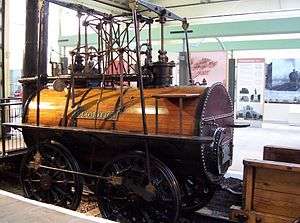Locomotion No. 1
|
Locomotion at Darlington Railway Centre and Museum | |||||||||||||||||||||||
| |||||||||||||||||||||||
| |||||||||||||||||||||||
| |||||||||||||||||||||||
| |||||||||||||||||||||||
Locomotion No. 1 (originally named Active) is the first steam locomotive to carry passengers on a public rail line, the Stockton and Darlington Railway. Built by George and Robert Stephenson's company Robert Stephenson and Company in 1825.
Design

Locomotion used all the improvements that George Stephenson had pioneered in the Killingworth locomotives. It used high-pressure steam from a centre-flue boiler, with a steam-blast in the chimney, to drive two vertical cylinders, enclosed within the boiler. A pair of yokes above them transmitted the power downwards, through pairs of connecting rods. It made use of a loose eccentric valve gear,[4] and was the first locomotive to use coupling rods to link its driving wheels together, rather than through a chain or gears. Because of the single flue, it had a poor heating surface compared to later steam locomotives. It had a top speed of 15 mph (24 km/h).[3]
This locomotive is historically important as the first to run on a public railway,[5] rather than for the innovations in its design. It hauled the first train on the Stockton and Darlington Railway in north-east England on 27 September 1825.
On 1 July 1828, the boiler exploded at Aycliffe Lane station, killing the driver John Cree.[6] With advances in design such as those incorporated into Robert Stephenson's Rocket, Locomotion became obsolete very quickly. It was rebuilt and remained in service until 1841 when it was turned into a stationary engine.
Preservation
In 1857 it was preserved. Locomotion No. 1 was on display in Alfred Kitching's workshop near Hopetown Carriage Works from 1857 to the 1880s. From 1892 to 1975 it was on display along with Derwent on one of the platforms at Darlington's main station, Bank Top. The locomotive is currently on display at the Darlington Railway Centre and Museum, now known as Head of Steam, in the same building as Darlington's North Road station. Locomotion is on long-term loan from the National Railway Museum and is part of the National Collection.
There is a working replica of the locomotive at Beamish Museum which was built in 1975.[7]
See also
- Locomotive No. 1 The first locomotive in New South Wales.
- Tom Thumb (first American steam locomotive)
References
- ↑ Ross, David (2004). British steam railways. Bath: Parragon. p. 15.
- ↑ Casserley, H.C. (1960). Historic locomotive pocket book. London: Batsford. p. 7.
- 1 2 "Locomotion No. 1, George Stephenson and the world's first public railway".
- ↑ Science Museum (1958). The British railway locomotive 1803–1850. London: Science Museum. p. 11.
- ↑ Casserley, H.C. (1976). Preserved locomotives (4th ed.). London: Ian Allan. p. 16. ISBN 071100725X.
- ↑ Hewison, Christian H. (1983). Locomotive Boiler Explosions. Newton Abbot: David & Charles. p. 26. ISBN 0715383051.
- ↑ Satow, F.; Satow, M.G.; Wilson, L.S. (1976). Locomotion — concept to creation: the story of the reproduction 1973–1975. Beamish: Locomotion Trust.
External links
| Wikimedia Commons has media related to Locomotion No.1. |
- Darlington Railway Centre and Museum
- Photograph of Locomotion at the Darlington Railway Museum
- Postcard of Locomotion at the Darlington Bank Top station in 1959
- http://www.spartacus-educational.com/RAlocomotion.htm
- Photo (1975) of locomotive Locomotion No.1 on display at Darlington main station
Coordinates: 54°32′10″N 1°33′18″W / 54.536°N 1.555°W
